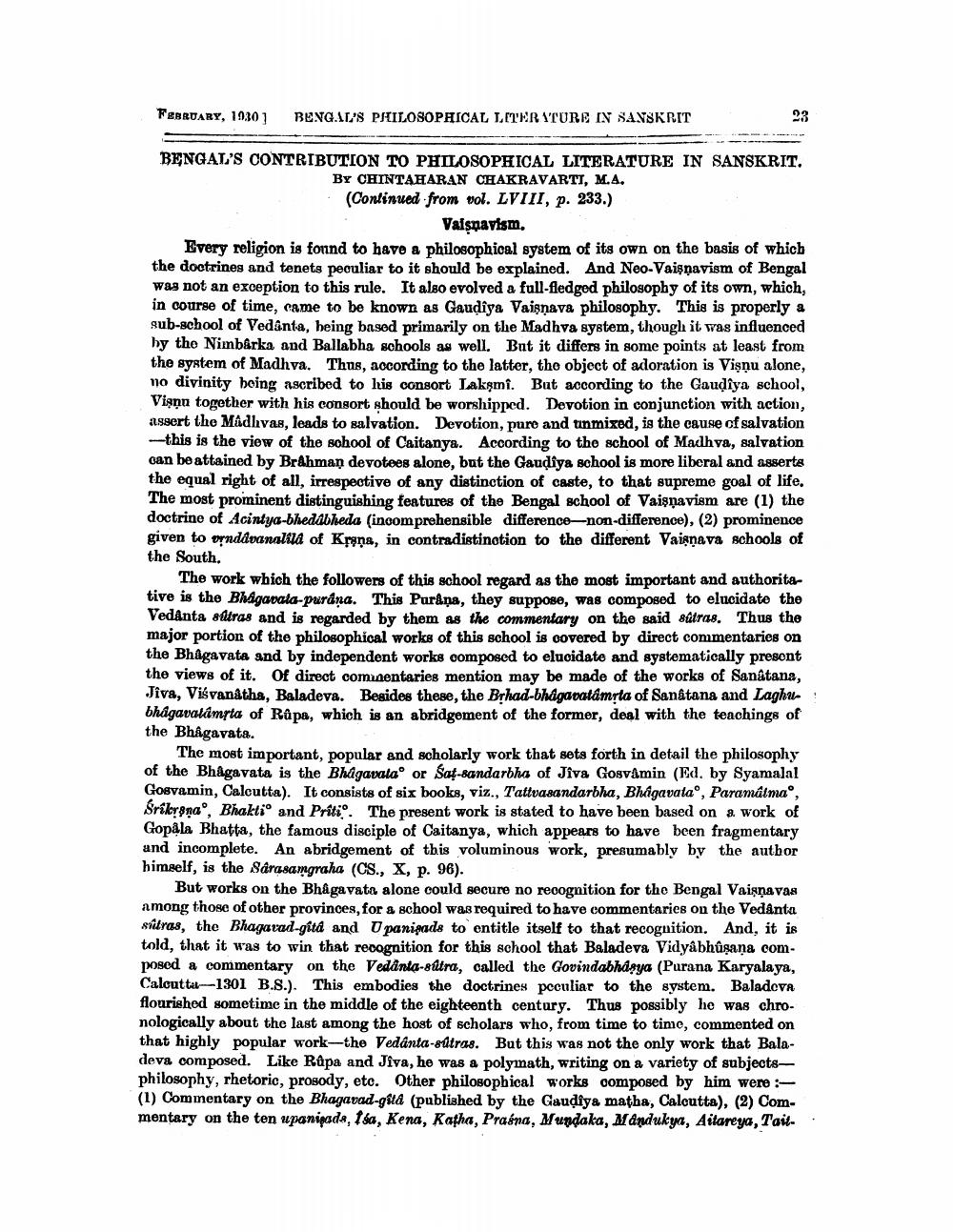________________
FEBRUARY, 1930 1
BENGAL'S PHILOSOPHICAL LITARYTURE IN SANSKRIT
BENGAL'S CONTRIBUTION TO PHILOSOPHICAL LITERATURE IN SANSKRIT.
BY CHINTAHARAN CHAKRAVARTI, M.A. (Continued from vol. LVIII, p. 233.)
Vaişpavism. Every religion is found to have a philosophical system of its own on the basis of which the doctrines and tenets peculiar to it should be explained. And Neo-Vaişņavism of Bengal was not an exception to this rule. It also evolved a full-fledged philosophy of its own, which, in course of time, came to be known as Gaudiya Vaisnava philosophy. This is properly a sub-school of Vedanta, being based primarily on the Madhva system, though it was influenced hy the Nimbarka and Ballabha schools as well. But it differs in some points at least from the system of Madhva. Thus, according to the latter, the object of adoration is Višņu alone, no divinity being ascribed to his consort Laksmî. But according to the Gaudiya school, Vişnn together with his congort should be worshipped. Devotion in conjunction with action, assert the Madhvas, leads to salvation. Devotion, puro and unmixed, is the cause of salvation --this is the view of the sohool of Caitanya. According to the school of Madhya, salvation can be attained by Brahman devotees alone, but the Gaudiya school is more liberal and asserts the equal right of all, irrespective of any distinction of caste, to that supreme goal of life. The most prominent distinguishing features of the Bengal school of Vaişņa vism are (1) the doctrine of Acintya-bhedabheda (incomprehensible difference-non-difference), (2) prominence given to urndavanaldia of Krena, in contradistinction to the different Vaianava schools of the South.
The work which the followers of this school regard as the most important and authorita tive is the Bhagavata-purana. This Purana, they suppose, was composed to elucidate the Vedanta sutras and is regarded by them as the commentary on the said sutras. Thus the major portion of the philosophical works of this school is covered by direct commentaries on the Bhagavata and by independent works composed to elucidate and systematically presont the views of it. Of direct comunentaries mention may be made of the works of Sanatana, Jiva, Visvanatha, Baladeva. Besides these, the Brhad-bhagavatámrta of Sanatana and Laghubhagavalámrta of Râpa, which is an abridgement of the former, deal with the teachings of the Bhågavata.
The most important, popular and scholarly work that sets forth in detail the philosophy of the Bhagavata is the Bhagavatao or Sat-sandarbha of Jiva Gosvamin (Ed. by Syamalal Gosvamin, Calcutta). It consists of six books, viz., Tattvasandarbha, Bhagavatao, Paramálmao, Srikrana', Bhaktio and Priti. The present work is stated to have been based on a work of Gopala Bhatta, the famous disciple of Caitanya, which appears to have been fragmentary and incomplete. An abridgement of this voluminous work, presumably by the author himself, is the Sarasamgraha (Cs., X, p. 96).
But works on the Bhagavata alone could secure no recognition for tho Bengal Vaisnavas among those of other provinces, for a school was required to have commentaries on the Vedanta sitras, the Bhagavad-gita and Upanipads to entitle itself to that recognition. And, it is told, that it was to win that recognition for this school that Baladeva Vidyabhûşana composed a commentary on the Vedanta-sdtra, called the Govindabharya (Purana Karyalaya, Calcutta--1301 B.S.). This embodies the doctrines peculiar to the system. Baladeva flourished sometime in the middle of the eighteenth century. Thus possibly he was chronologically about the last among the host of scholars who, from time to time, commented on that highly popular work--the Vedanta-sútras. But this was not the only work that Baladeva composed. Like Râpa and Jiva, he was a polymath, writing on a variety of subjectsphilosophy, rhetoric, prosody, etc. Other philosophical works composed by him were : (1) Commentary on the Bhagavad-gita (published by the Gaudiya matha, Calcutta), (2) Commentary on the ten upanipoda, tsa, Kena, Katha, Praena, Mundaka, Mandukya, Aitareya, Tait.




